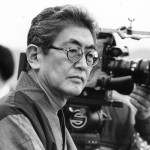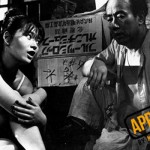Review: The Man Who Left His Will On Film (1970)
To begin to understand Nagisa Oshima’s The Man Who Left His Will On Film, one must first understand the relative importance of cinema and its various capacities. Cinema can be used for narrative delivery, but the power of the succession of static images is far more diverse than a simple tool for entertainment. It has the capacity for enlightenment, entertainment, the transmission of ideas and philosophies, a political weapon, and an infinite number of other possibilities. I can no more articulate the reasons that film as an artistic medium was so important to Nagisa Oshima than I can articulate why it is important to me. There are many contradictory elements of my own personality and personal philosophies, and articulating why I have chosen this particular means of artistic expression as a lifelong passion is a mystery even to me.
The Man Who Left His Will On Film is the work of a man desperately lost and in a futile search for some rationalization to aid in the contextualization of his chosen means of expression. This is a film about the creative process and the self-doubt of a man uncertain of his own identity. Oshima found that he was unable to figure out his place in the world when the empty promises of the leftist movements were just as disenfranchising as the established power at the time. The social conditions in late sixties Japan would be a source of disillusionment for Oshima, as his sense of personal identity was lost after he found himself unable to work under the restrictions of the Japanese studio system, but just as incapable of creating his vision because of the myopia of the radicalized leftist movements.
The opening scene in The Man Who Left His Will On Film is a perfect illustration of the loss of personal identity that Oshima was experiencing during these confusing times. The film opens on the silhouette of a young Japanese man. Discordant music plays in the background offering the soundtrack for the discordant nature of those times. This discordant music continues playing until the frame explodes and is replaced by handheld shots of a Japanese street, and police officers are pursuing this young artist to try and confiscate his camera. The handheld camera work that opens these scenes is frantic as the young artist has an urgent need to capture a few final frames before the establishment takes away his camera, and his last few reasons that make existence tolerable.
The camera is seen as a mythic artifact, wielding mysterious and frightening powers. It must be controlled and the establishment distrusts the youth and their ability to properly control this mystical weapon of “truth”. The youth on the left also fear the camera’s power, but their anti-individualist philosophies and communal nature make it difficult to choose a “worthy” subject to expose to their priceless film reels. They spin their wheels in pseudo-intellectual exchanges about film and its power, meanwhile unable to actually create anything.
One might interpret scenes of young radicals discussing a worthwhile film project as Oshima taking sides with their cause. One must know of Oshima’s attitude at the time to properly interpret these scenes. He found just as much hypocrisy on both sides of the argument, and the students in his film are mindless pontificators; unknowing and without life experiences to add weight to their naïve Godardesque drivel. There is a contradictory nature to their anti-individualist sentiments, as the creative process loses steam when filtered through the naiveté of pock-marked know-it-all leftist radicals. Auteur filmmaking requires individuality as it is a means to express a singular inner-vision of an artist. When you take that control away, the power is lost through cultural dogma and two-dimensional propagandistic platitudes.
Oshima explores the negative impacts of the captured image and the mitigating effects it has on actual visceral experiences. It creates a layer of separation between the observer and the action, and makes the pain of existence slightly more manageable. Oshima also explores how cinema is also very limited in its ability to capture truth. The individuality of the filmmaker, or the communal thought processes of the group work to decide where the camera should be pointed. Since it is incapable of being pointed in all directions at once, it inherently falsifies the information it collects through the omission of the majority of the environment around the event being captured. It omits the unquantifiable elements that are the heart of what little truth exists in the universe, but who ever said that film had to tell the truth?
When you have this knowledge you are able to peel away the surface layers and find harmonic resonance with the work that illustrates that most of film’s power is derived from the subtext. If you are trying to quantify the unquantifiable to simply service your own agenda, then you are merely creating work that is a reactionary subversion of the status-quo. This is a perfectly fine way to express one side of an idea, but to pretend that it represents some sort of universal truth can be arrogant and misguided. Ironically, one can critique the “politics” of artistic expression while being unwittingly bound to their fallacies. Once you have fully embraced this mitigation of truth and the contradictions inherent in artistic creation, then you can try to inform your work with this knowledge and use the hypocrisy to illustrate itself in a mind-bending self-reflection.
Alas, this confusing and contradictory philosophy should not be dwelled upon too deeply, or it will stop the artistic process dead in its tracks. There are many forms of thought, many techniques of expression, and there are an infinite number of colors in the cinematic crayon box. No method of expression is more correct than the other, and whatever power that the audience places in the indifferent hands of a work of art is as transient as the universe itself. If you want to be an artist, go be an artist. If you want to be a writer, go be a writer. You needn’t ask permission, nor run your ideas by any committee, just find whatever it is in your subconscious that is begging to be expressed and go out and express it. Oshima did this despite the financial difficulties of using film as a medium of expression, and his embracing of the multifaceted and conflicted nature within him was at least partially responsible for the power of his work. So here I sit at the end of this review, desperately trying to interpret my inner thoughts in to words to convince others of the importance of this film. I find myself unable to properly convey the contradictions without ending up in a convoluted recursive loop, but here it is. Such as it is.
Related Posts
![]()
Matthew Blevins
![]()
Latest posts by Matthew Blevins (see all)































